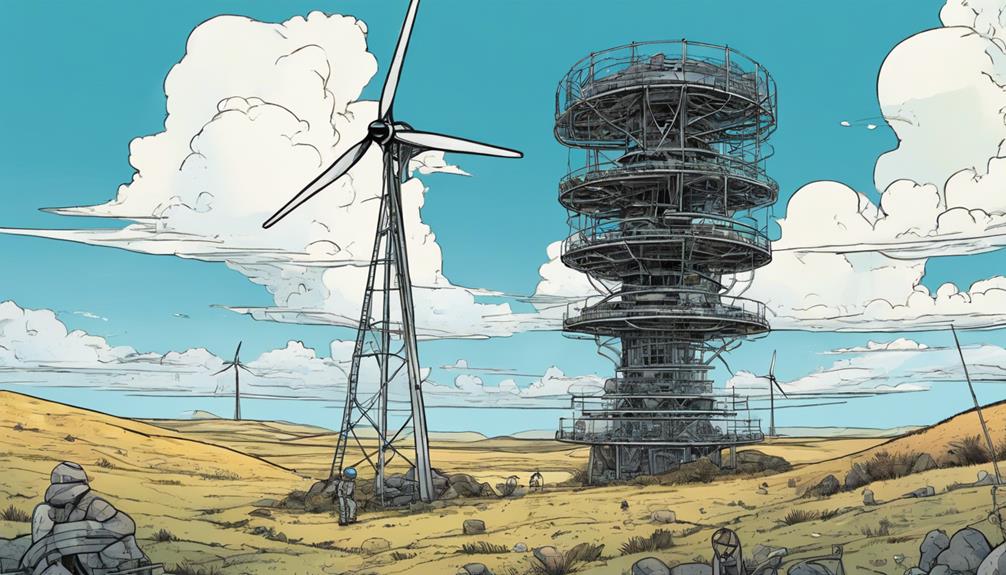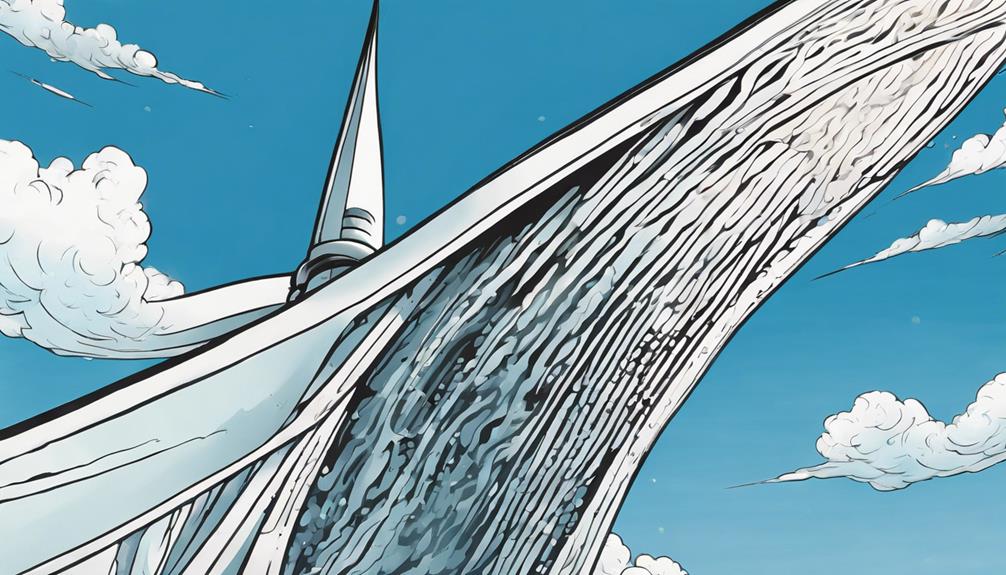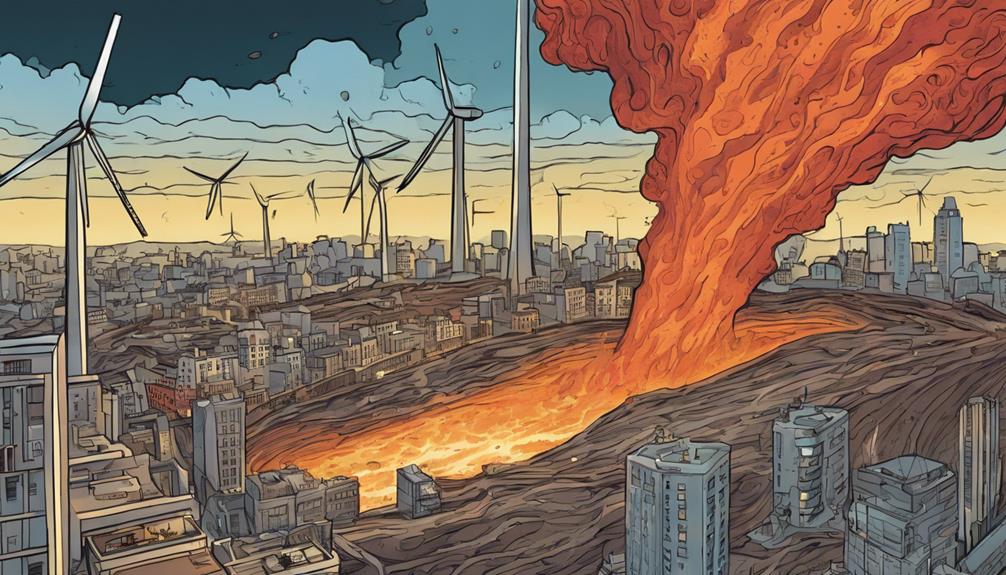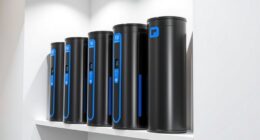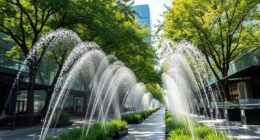Optimizing wind turbine towers is critical to guarantee safety, efficiency, and long-term performance. A well-designed tower can greatly impact the overall productivity and reliability of a wind farm. Key considerations include material selection, structural integrity, maintenance accessibility, and regulatory compliance. Factors like wind speed, turbine dimensions, and environmental elements also influence design. Blade configuration, material durability, and structural design risks must also be carefully evaluated. By understanding these complex factors, wind turbine towers can be fine-tuned for peak performance and safety. Explore the intricacies of tower design to harness the full potential of wind energy.
Key Takeaways
- Material selection is critical for withstanding harsh weather conditions and supporting the weight of the nacelle and rotor.
- Structural integrity must consider the turbine's size, weight, and environmental factors like wind speed and direction.
- Maintenance accessibility is pivotal for long-term efficiency, ensuring easy replacement of components and reducing downtime.
- Regulatory compliance is essential for safety standards, ensuring adherence to industry guidelines and regulations.
- Load calculations and seismic analysis are vital for identifying and mitigating structural design risks, ensuring stability and reliability.
Tower Design Considerations
When designing a wind turbine tower, several key factors come into play, including material selection, structural integrity, maintenance accessibility, regulatory compliance, and installation considerations. All of these factors greatly impact the overall efficiency and reliability of the turbine.
The tower's material must be able to withstand harsh weather conditions, support the weight of the nacelle and rotor, and ensure stability. Structural design must consider the turbine's size and weight, as well as environmental factors like wind speed and direction.
Maintenance accessibility is pivotal for long-term efficiency, and regulatory compliance is essential for safety standards. Proper installation and commissioning are also essential for operational success.
Factors Influencing Design

Several factors influence wind turbine tower design, necessitating meticulous consideration to guarantee peak performance and safety. Wind velocity and direction impact power generation. Turbine dimensions and mass influence construction needs. Available area and terrain limitations determine the tower's footprint and installation approach.
Environmental elements like weather and soil conditions play a vital role, as do seismic and hurricane risks, impacting design and maintenance strategies. By comprehending and addressing these factors, wind turbine tower designers can craft optimized structures that ensure dependable, effective, and secure operation.
Blade Configuration Efficiency

The configuration of wind turbine blades greatly impacts the overall efficiency and energy production of a wind farm. The number of blades is a critical determinant of performance, with the ideal blade configuration depending on various factors including budget, environmental conditions, and desired energy output.
Two-blade turbines offer cost-effectiveness and simplicity, making them suitable for small-scale projects or areas with low wind speeds.
Three-blade turbines provide a balance between efficiency and noise reduction, making them a popular choice for commercial wind farms.
Four and five-blade turbines prioritize stability and energy production, often used in high-wind areas or for large-scale projects.
Material Durability Matters

Most wind turbine towers rely on durable materials to withstand extreme weather conditions, support the turbine's weight, and secure long-term efficiency. The selection of materials is critical, as it directly impacts the tower's stability, reliability, and overall performance.
Lightweight materials, such as advanced high-strength steel and fiber-reinforced polymers, are increasingly popular due to their ability to enhance operational efficiency while reducing construction costs. However, these materials must also demonstrate rust resistance and corrosion protection to secure longevity.
Additionally, the materials used must be able to support the turbine's weight and withstand extreme weather conditions, including high winds, earthquakes, and hurricanes.
Structural Design Risks

Identifying and mitigating structural design risks is essential to guarantee wind turbine towers can withstand extreme loads and environmental stresses, thereby preventing catastrophic failures and maintaining peak performance. A thorough risk assessment is crucial to identify potential hazards, such as seismic activity, high winds, and corrosion.
Load calculations must be accurate to guarantee the tower can support the weight of the nacelle and rotor blades.
Seismic analysis is vital to design towers that can resist earthquakes and other seismic events.
Hazard identification helps to detect potential failure points, allowing designers to implement measures to prevent or mitigate them.
Frequently Asked Questions
What Is the Ideal Wind Turbine Tower Height for Maximum Energy Production?
They determine the ideal wind turbine tower height by balancing hub height, rotor diameter, and wind speeds to maximize energy production, typically ranging from 80 to 100 meters, depending on site-specific conditions.
How Does Turbine Tower Design Impact Local Wildlife Habitats and Ecosystems?
She notes that turbine tower design greatly affects local wildlife habitats and ecosystems, as tower location, height, and layout can disrupt migration patterns, habitats, and feeding grounds, necessitating careful environmental impact assessments.
Can Wind Turbine Towers Be Designed for Hybrid Renewable Energy Systems?
They can design wind turbine towers to integrate with other renewable energy sources, such as solar panels or hydrogen fuel cells, to create hybrid systems, increasing overall energy output and reducing reliance on fossil fuels.
What Role Does Artificial Intelligence Play in Wind Turbine Tower Optimization?
AI's clever fingers weave a tapestry of optimization, precision-crafting wind turbine towers to dance with the wind, harnessing every gust to maximize energy harvest, while minimizing costs and environmental impact.
Are There Any Emerging Trends in Wind Turbine Tower Design and Construction?
Emerging trends in wind turbine tower design and construction include the use of advanced materials, modular designs, and 3D printing, which enhance efficiency, reduce costs, and improve sustainability.
How Can Wind Turbine Towers be Optimized for Safety and Efficiency to Maximize Turbine Benefits?
When it comes to maximizing wind turbine benefits, optimizing the design and construction of wind turbine towers is essential. By utilizing strong and durable materials, implementing efficient design techniques, and conducting regular maintenance and safety inspections, wind turbine towers can be optimized for safety and efficiency, ultimately maximizing wind turbine benefits.
Conclusion
In the pursuit of a sustainable future, optimizing wind turbine towers is essential. By considering the intricate dance of wind speed, direction, and environmental conditions, designers can create structures that not only harness energy efficiently but also guarantee safety standards.
As the industry continues to evolve, one thing is clear: a well-designed tower is the backbone of a successful wind farm, and its significance can't be overstated – it's the wind beneath their wings.
